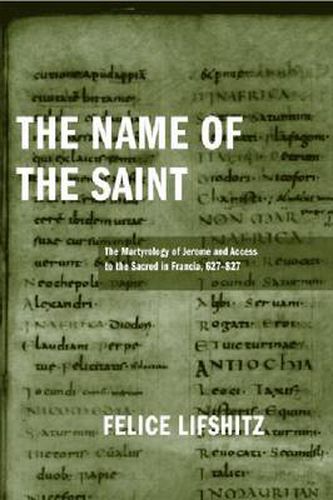Readings Newsletter
Become a Readings Member to make your shopping experience even easier.
Sign in or sign up for free!
You’re not far away from qualifying for FREE standard shipping within Australia
You’ve qualified for FREE standard shipping within Australia
The cart is loading…






The Name of the Saint is a study of the spiritual, social, and liturgical practices of reciting, inscribing, collecting, and bearing saints’ names from the seventh through the ninth century. These practices, called in manuscript sources the sanctorum nominum festivitas, were extremely rare among Christians during the early middle ages, when most people preferred to access the realm of sacred power through other routes, such as the relics, images, and life stories of saints. Felice Lifshitz’s study, based on careful analysis of manuscript martyrologies, sacramentaries, and calendars, reveals that those individuals who did embrace name-centered piety (such as Willibrord-Clement of Echternach and Witiza-Benedict of Aniane) had in common both close connections with the Carolingian family and a familiarity with the Martyrology of Jerome. Despite their importance to medieval life, martyrologies and calendars have been virtually ignored by scholars other than liturgists. Lifshitz’s discussion of these neglected materials reveals the existence of alternative and under-appreciated routes of access to the sacred. It also situates the rise of this alternative practice in a particular political context and elucidates the history of the widely misunderstood Martyrology of Jerome. This important new work explains an important body of source material and proposes a new way of thinking about early medieval spirituality and the place of saints and sanctity in that spirituality.
$9.00 standard shipping within Australia
FREE standard shipping within Australia for orders over $100.00
Express & International shipping calculated at checkout
The Name of the Saint is a study of the spiritual, social, and liturgical practices of reciting, inscribing, collecting, and bearing saints’ names from the seventh through the ninth century. These practices, called in manuscript sources the sanctorum nominum festivitas, were extremely rare among Christians during the early middle ages, when most people preferred to access the realm of sacred power through other routes, such as the relics, images, and life stories of saints. Felice Lifshitz’s study, based on careful analysis of manuscript martyrologies, sacramentaries, and calendars, reveals that those individuals who did embrace name-centered piety (such as Willibrord-Clement of Echternach and Witiza-Benedict of Aniane) had in common both close connections with the Carolingian family and a familiarity with the Martyrology of Jerome. Despite their importance to medieval life, martyrologies and calendars have been virtually ignored by scholars other than liturgists. Lifshitz’s discussion of these neglected materials reveals the existence of alternative and under-appreciated routes of access to the sacred. It also situates the rise of this alternative practice in a particular political context and elucidates the history of the widely misunderstood Martyrology of Jerome. This important new work explains an important body of source material and proposes a new way of thinking about early medieval spirituality and the place of saints and sanctity in that spirituality.